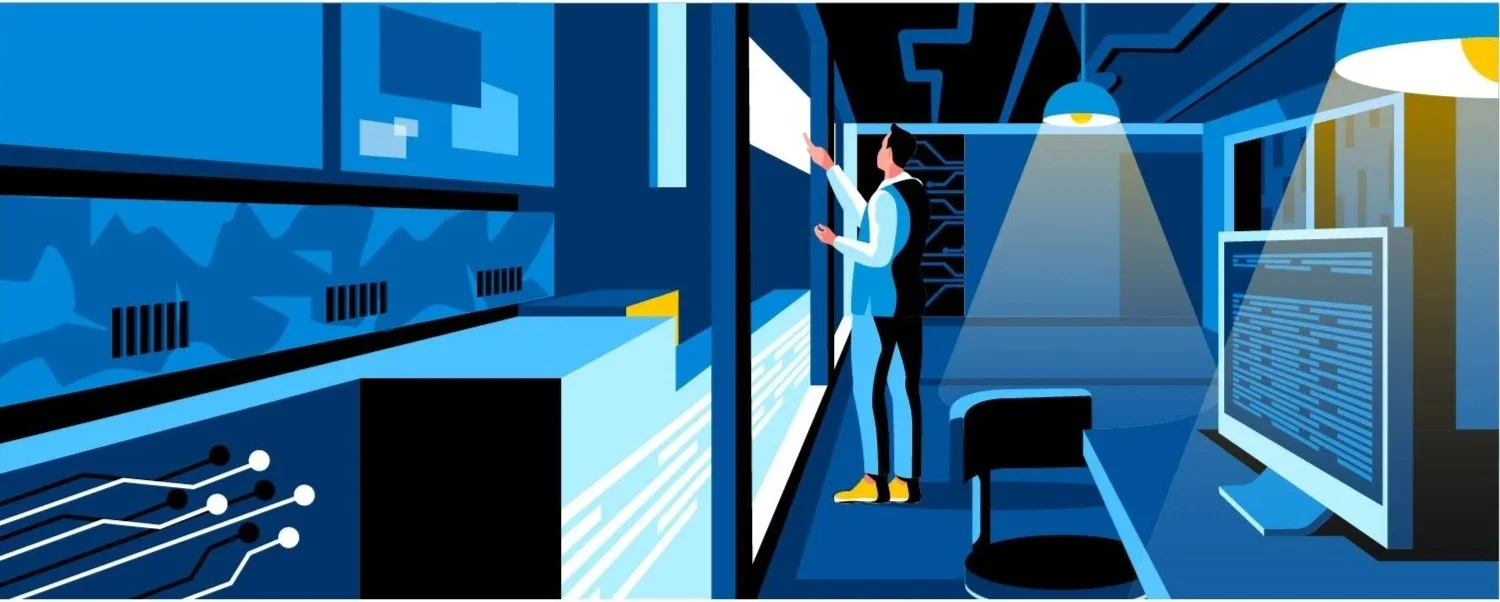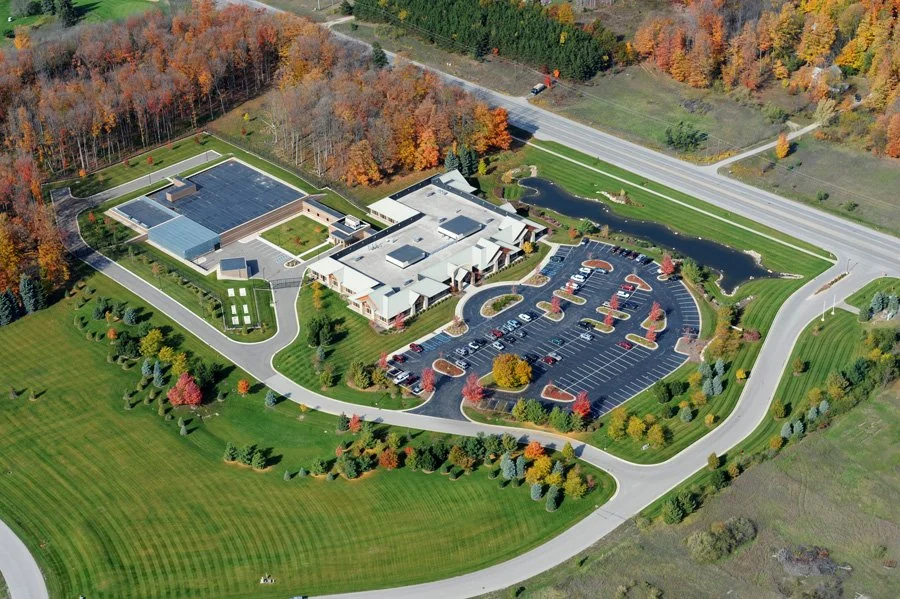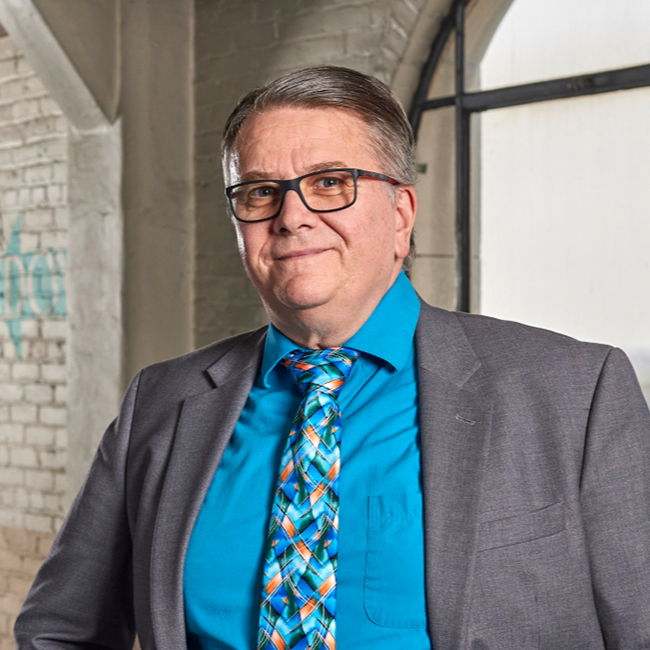Future-Proof or Fall Behind: How Smarter Data Center Design Will Define the AI Era
Artificial intelligence is reshaping industries across the globe. At the center of this transformation is the data center. The rise of AI brings a rise in agentic AI systems: applications that are not just responding to commands, but initiating actions, making decisions, and running continuous processes in the background. This level of computing activity means exponentially higher energy loads, sustained power demand, and the need for rapid data processing and thermal management. The next generation of data centers must be more than just high-tech. They must be resilient, sustainable, and built with long-term adaptability in mind.
At Albert Kahn, our teams are exploring how integrated electrical, architectural, mechanical, and sustainability strategies are shaping the future of data centers. This article draws from our experience in designing complex, future-ready facilities across healthcare, insurance, financial, and corporate sectors, and how we’re preparing clients to meet the demands of the AI era.
Powering the AI Boom
High-density AI computing has dramatically increased energy requirements. Traditional watts-per-square-foot models, once based on 5 to 15 kW per rack, are now outdated. Rack power density has jumped to 60 to 120 kW today, and some facilities are already exceeding 100 kW per rack with emerging GPU hardware [1]. This exponential jump requires an entirely new approach to electrical power and mechanical cooling planning.
Transformers, UPS systems, and switchgear must be sized and arranged to meet these future loads. Battery Energy Storage Systems (BESS) are increasingly augmenting or replacing diesel generators, offering quieter, cleaner, and more responsive backup power with the added benefit of grid support services such as peak shaving. While flywheel and battery systems provide valuable ride-through capabilities during short interruptions, their limited duration means they are typically not sufficient alone for extended emergencies, where traditional diesel generators or other long-duration backup systems may still be necessary. In cases of very large Data Centers dual fuel natural gas/diesel turbine generators that incorporate waste heat recovery with the heat utilized in an absorption chiller to provide cooling to the facility. This can be especially cost effective in areas that have very high electrical utility cost or not enough electrical power available from the grid.
One significant challenge is real estate. The real estate required for electrical distribution equipment has grown tremendously, particularly when building in redundancy for AI-scale computing. This is changing how engineers and architects collaborate during early planning phases.
At the Henry Ford West Bloomfield Hospital Data Center, Albert Kahn designed a fully redundant electrical system with provisions for dual-source normal power, paralleled 2 MW generators (N+1 configuration), and a dedicated emergency switchboard. We planned with future growth and expansion in mind, including extra square footage and space for an additional generator. This approach not only ensured reliability in a mission-critical healthcare setting but also gave the hospital a flexible growth pathway without future downtime or costly infrastructure overhauls. The significance lies in the foresight and intentionality of planning for redundancy and scalability in a space where lives and operations depend on uninterrupted data and power delivery.
Designing for Density: AI’s Unique Infrastructure Demands
AI workloads place entirely new pressures on data centers, far beyond traditional CPU-driven models. Third-party data and industry trends reinforce this shift:
Rack power density has jumped from 5 to 15 kW a decade ago to 60 to 120 kW today, and some facilities are already exceeding 100 kW per rack with emerging GPU hardware [2].
McKinsey projects that by 2030, around 70 percent of data center capacity will need to support advanced AI workloads [3].
Goldman Sachs forecasts global data center power demand to grow as much as 165 percent by 2030 [4].
These figures matter because they illustrate a fundamental change in what data centers must do and how they must be built. AI workloads demand sustained power, not just bursts, meaning elevated capacity planning, denser electrical distribution, and more precise thermal control.
Why this matters:
Sustained high-density power: Whereas traditional data centers handle intermittent peaks, AI racks operate consistently at 50 to 100 kW. This requires more robust transformers, UPS, and switchgear design upfront without wasting capacity in low-use times.
Targeted cooling strategies: Standard air cooling cannot cope with the concentrated heat loads. High-density zones require liquid or hybrid cooling systems, which can be up to 3,000 times more efficient in removing heat [5], while limiting energy spikes.
Thermal zoning in design: Precision cooling means separating high-density AI zones from general IT spaces. Doing so minimizes overcooling and conserves energy. AI-powered control systems can further optimize fan speeds and coolant flow in real time.
Properly incorporating these systems requires early collaboration between mechanical engineers, electrical engineers, and architects to balance airflow, chilled water loop design, redundancy strategies, and white space allocation. The mechanical team’s ability to model and zone heat-intensive areas directly influences the efficiency and longevity of the entire facility.
This kind of integrated planning results in design strategies with measurable impact. At Albert Kahn, we translate these demands into practical, scalable systems such as:
Modular, specialized electrical containers adjacent to white space, minimizing footprint while enabling rapid deployment and future upgrades
Phased infrastructure rollouts that align with growth projections, reducing upfront costs without limiting long-term capacity
Hybrid cooling pathways that combine air and liquid systems, delivering precise thermal management tailored to each rack zone
Each of these approaches supports the broader goal of designing facilities that are not only capable of supporting today’s AI infrastructure, but also ready to adapt to tomorrow’s technologies without requiring full redesigns.
Architecture That Enables Growth
AI data centers are no longer static. They must be modular, reconfigurable, and scalable. But this scalability must also be strategic. It must work in service of continuity, cost, and resiliency.
Architecture plays a pivotal role in making that possible. The layout and structure of the facility itself can either enable or inhibit a data center’s ability to grow alongside its operational demands. At Albert Kahn Associates, we’ve seen firsthand how long-term thinking in design can pay dividends for our clients, not just in performance, but in resilience, energy savings, and cost control.
Consider the following examples:
Auto-Owners Remote Disaster Recovery Data Center
Jackson National Life Insurance Remote Data Center: This 56,860-square-foot facility was built with security, resiliency, and phased growth at its core. Backup generators and mechanical equipment were installed in a walled courtyard with a grated overhead enclosure, providing critical protection from high winds and airborne debris during storm events. Additional flood mitigation measures were incorporated to prevent water ingress and safeguard backup power systems. Isolated mechanical corridors allowed essential systems to be maintained or expanded without disrupting mission-critical operations. This forward-looking approach gave Jackson the ability to grow its digital infrastructure in sync with business demands. These choices reduced risk, minimized potential downtime, and made future upgrades easier, faster, and more cost-effective.
Auto-Owners Remote Disaster Recovery Data Center: Designed into a hillside, the building leverages earth sheltering to reduce thermal gain and improve resilience. Natural insulation supports both security and operational stability. By reducing reliance on mechanical cooling and enabling modular construction zones for phased equipment installation, this facility delivered a truly sustainable and adaptive design.
Delta Dental Data Center: This semi-recessed Tier III facility was designed for 24/7 uptime, with reinforced enclosures and off-site security infrastructure. Its architectural structure helps maintain stable internal environments while allowing for future retrofits with minimal disruption. It is a strong example of balancing performance, longevity, and adaptability.
Nissan Technical Center North America (NTCNA): A range of sustainable strategies at Nissan Technical Center North America (NTCNA) work together to reduce greenhouse gas emissions and lower operating costs. One of the larger components in the facility is a thermal ice storage system cutting emissions and reducing peak electrical demand by using low-temperature chillers to produce ice overnight, taking advantage of lower off-peak electricity rates. During the day, the stored ice is used to generate chilled water for cooling, minimizing energy use when rates are highest.
Across all of these, the theme is simple: build what you need today but make it easy to expand tomorrow without disruption. Architecture, engineering, and systems design must work in sync to make that possible.
Prefabricated electrical equipment containers are also gaining popularity as a potential option in certain project scenarios. These modular systems integrate power distribution, fire suppression, and cooling within factory-assembled enclosures and can offer benefits such as reduced commissioning time and preserved interior data hall space. However, they may present trade-offs, including limited maintenance access, challenges with future system modifications, and extended feeder runs due to placement at the perimeter. Because of these variables, containerized switchgear should be evaluated within the broader context of the project’s long-term needs, access constraints, and operational goals.
Sustainable Systems Integration
Data centers have historically been seen as energy hogs. But that perception is shifting, and the industry has an opportunity to lead. Sustainability is no longer a value-add. It is a critical component of future-proofing.
Systems must work together to reduce environmental load and handle increasing natural disasters, not just meet baseline code requirements. This integration only works when sustainability goals are embedded at the outset. Everything from building orientation and envelope design to material selection and system zoning must align with performance goals.
Jackson National Life Insurance Remote Data Center
At Albert Kahn, we approach sustainability as a systems-level challenge. That means designing for mutual benefit, performance, and readiness for emerging technologies. Looking ahead to the next five to ten years, we anticipate broader adoption of:
Liquid immersion cooling technologies are emerging as a promising alternative for high-density heat management, though their adoption remains limited due to maintenance complexity.
Closed-loop water recycling and air handling systems for minimal environmental discharge, consistent with best practices in liquid cooling that require contaminant-free operation.
Modular construction techniques using materials with known recycled content percentages, combined with digital twin simulations, enabling better circularity, transparency, and lifecycle analysis.
AI-managed predictive maintenance platforms that integrate carbon tracking, energy optimization, and life-cycle planning in real time.
These strategies build on the integrated practices already in place, with mutual benefit in mind, including:
Waste heat reuse: Liquid coolant loops are always closed systems and must remain contaminant-free. However, air-cooled systems or secondary heat exchangers can be used to safely capture and redirect server heat to support adjacent buildings, such as offices or greenhouses. This reduces HVAC strain and offsets heating loads, especially on university or hospital campuses with steady demand.
On-site renewables and future-ready infrastructure: While rooftop solar can be challenging in high-density data centers due to HVAC requirements and roof loading constraints, particularly with traditional air-cooled systems, the move toward liquid cooling may open up new opportunities. Our infrastructure strategies include evaluating solar-ready roof structures (where feasible), PV conduit planning, and adjacent land strategies that could support solar carports or other distributed energy resources. BESS systems and ice storage can be designed to pair with these features to provide peak shaving and battery backup.
Smart monitoring platforms and controls: Real-time analytics drive efficiency through predictive cooling, airflow balancing, maintenance alerts, and fault detection.
Innovative materials and low-carbon construction: Emerging strategies include carbon-storing concrete alternatives and high-performance envelope assemblies. Architects and engineers are incorporating Embodied Carbon Tracking and Life Cycle Analysis (planning for end-of-life use) into early decision-making to help offset both carbon impacts and long-term costs. These actions also help with certifications such as LEED v5.1 and the upcoming SBTi-aligned standards for data centers.
Many organizations are now bringing their own power online through on-site generation or storage systems, balancing flexibility with operational control. Fossil fuel-based generation is still common for prime or backup power, but it requires compliance with stringent emissions regulations that can add significant cost—though these requirements may fluctuate with future policy changes. Microgrids, while often promoted as a sustainable solution, are in fact foundational to any on-site energy strategy. When properly designed, microgrids can integrate and regulate multiple energy sources—including fossil fuels, battery storage, solar, and wind—to optimize energy mix, enhance resiliency, and improve response during emergencies. As such, they should be considered not only for their sustainability benefits but also as a platform for energy flexibility and long-term operational stability.
Sustainability is not a silo. It is a shared responsibility across disciplines, and a cornerstone of how we define smarter data center design.
Designing for What’s Next
If AI is the defining workload of our time, then data centers must evolve at the same pace. This means designing not just for today’s technologies, but for those that will emerge in the next five to ten years.
At Albert Kahn Associates, we view adaptability as the new benchmark of value. Facilities must be easy to reconfigure, quick to scale, and smart enough to self-optimize. Every system, from power to cooling to layout, should be modular, resilient, and integrated with sustainability in mind.
The path forward requires deep collaboration across disciplines and a shared commitment to performance, efficiency, and longevity. As more organizations embrace AI and other emerging technologies, the data centers that support them will become the backbone of global innovation.
The future will belong to those who build for it.
Sources:
[1] Uptime Institute. 2023 Global Data Center Survey. https://uptimeinstitute.com
[2] NVIDIA. "Powering the Next Generation of AI Data Centers." https://nvidia.com
[3] McKinsey & Company. "The data center challenge: Charting a sustainable path forward." https://mckinsey.com
[4] Goldman Sachs. "The Future of Data Centers." Equity Research Report, 2023.
[5] ASHRAE. "Liquid Cooling Guidelines for Datacom Equipment Centers." https://ashrae.org
Article Contributors:
Philip Garland, PE, LEED AP BD+C
Director of Electrical Engineering
Senior Associate
Cody Hansen, AIA, NCARB, LEED GA
Architect
Associate
Russell LaBeau
IT Systems
Autodesk Administrator
Sean Pic-Kell, PE
Senior Electrical Engineer
Technical Principal









